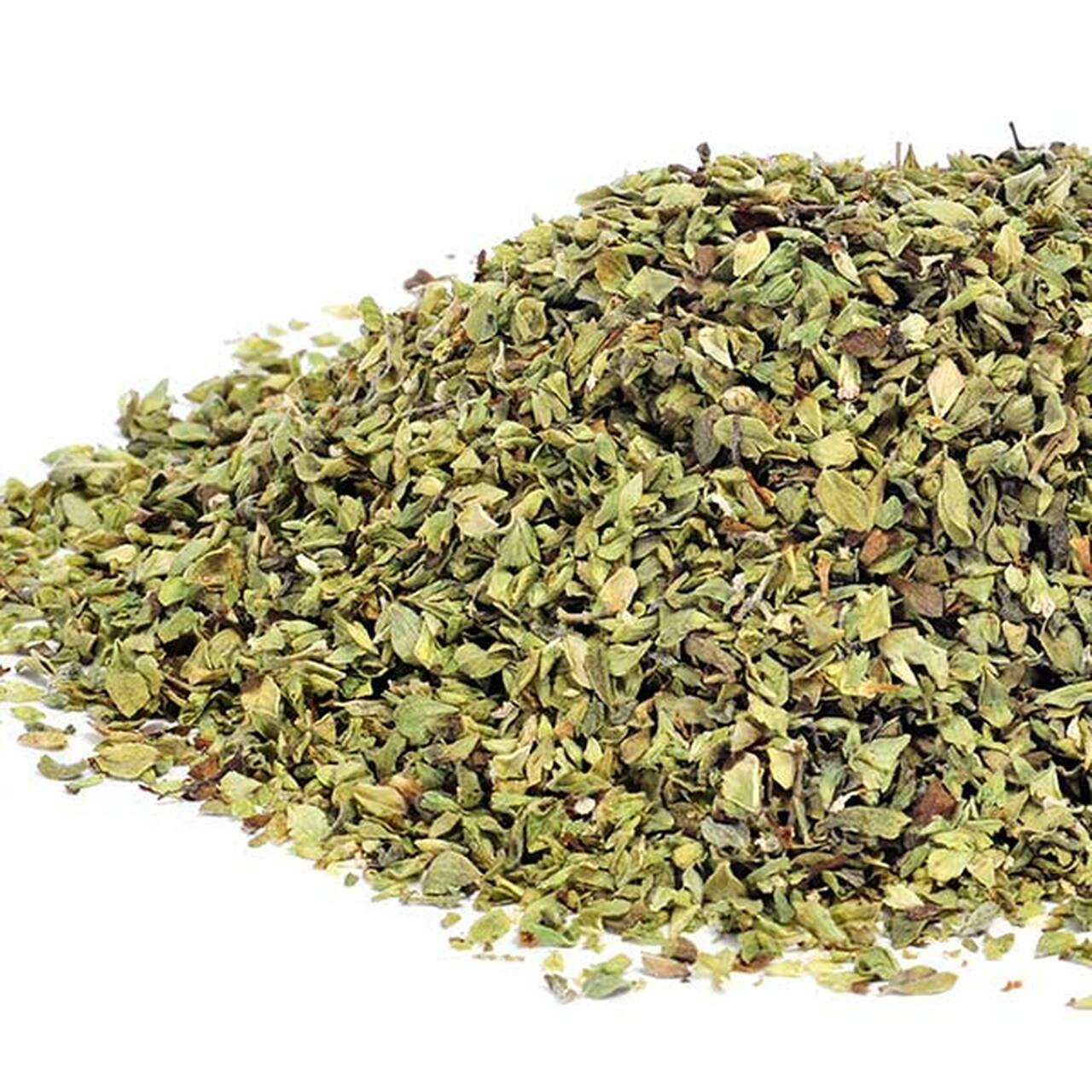Marjoram Origanum majorana dried Leaves in bulk packaging shipped in 20″ FCL container
Login to view prices
Common name: Sweet Marjoram
Latin name: Origanum majorana L.
Family: Lamiaceae (Labiatae)
Other names: Engl.: sweet marjoram, knotted marjoram, marjoram. Deu.: Majoran, Mairan, Wurstkraut. Suom.: maustemeirami, meirami. Sven.: mejram, kloka gumman, myrrah, origano, sluga gubbem. Fran.: marjolaine. Port.: manjerona. Span.: mejorana. Bot. syn.: Majorana hortensis Moench, Majorana majorana (L.) Karst., Origanum majoranoides Willd.
It was formerly classified as Majorana hortensis Moench.
Interesting to note that the Tunisians call their Marjoram Khezama, which is Arabic for Lavender
Botanical Origin:
Common name: Sweet Marjoram
Latin name: Origanum majorana L.
Family: Lamiaceae (Labiatae)
Other names: Engl.: sweet marjoram, knotted marjoram, marjoram. Deu.: Majoran, Mairan, Wurstkraut. Suom.: maustemeirami, meirami. Sven.: mejram, kloka gumman, myrrah, origano, sluga gubbem. Fran.: marjolaine. Port.: manjerona. Span.: mejorana. Bot. syn.: Majorana hortensis Moench, Majorana majorana (L.) Karst., Origanum majoranoides Willd.
It was formerly classified as Majorana hortensis Moench.
Interesting to note that the Tunisians call their Marjoram Khezama, which is Arabic for Lavender
Description:
Sweet marjoram (Origanum majorana L.) grows in bunches or tufts 8 to 16 in. high (0.5 meters). The flowers are small, greenish white or pink to purplish. The stem is erect, glabrous to tomentose. The seeds oblong, very fine and dark brown in color; the leaves small, ovate, gray-green, and soft.
Range & Habitat:
Sweet marjoram (Origanum majorana L.) is a tender perennial herb native to North Africa and southwest Asia and naturalized in southern Europe. Marjoram is cultivated in France, Greece, Hungary, Egypt, and several other Mediterranean countries.
Marjoram is primarily a warm climate plant and, as such, rather sensitive to cold. Yet it is hardy enough to grow in cooler regions, provided the plants are well mulched with straw or leaves for protection against winter killing or, still better, grown as an annual crop and planted anew each season.
Great care must be taken to select the loose soil, or much of the planted seed will be lost. The ground should be well drained, exposed to ample sunlight, fertilized and irrigated. Although the plant resists drought, prolonged periods of dryness are harmful.
The climate seems to exercise considerable influence upon the shape of the plants, those cultivated in Tunis growing sometimes more than 3 ft. high.
Generally, the reported life zone of marjoram is 6 to 28.8ºC with an annual precipitation of 0.5 to 2.7 meters and a soil pH of 4.9 to 8.7 (preferably alkaline). The plant is adapted to well-drained, fertile loam soils. The cold-sensitive plant cannot survive northern climates.
Although Hungary produces a small amount of oil, France and Egypt are probably the largest producers, while Tunisia and Bulgaria are gradually increasing their output
Planting & Cultivation:
For cultivation, marjoram is both seeded directly and transplanted into fields.
In Germany, the seed is sown in April with drills directly in the fields. The plants grow very densely in the rows which are spread 8 to 9 in. apart. The plants must be resown every spring. Cutting takes place in August and September.
In Hungary, the seed is sown in hotbeds. Toward the end of April the young plants are transplanted, 25 cm apart, in rows 30 cm distant. Six to eight young plants are usually planted together. About a week after transplanting, the field is hoed for the first time, a practice repeated every three or four weeks. The first harvest takes place at the end of June, when the plants are cut 1 to 2 cm above the ground. The second harvest is at the beginning of August; if possible, a third one takes place toward the end of September.
In France, seeds are selected from the best plants and sown in nurseries; when the young plants are sufficiently strong, they can be transplanted. Frequent weeding, hoeing, and watering is necessary. The harvest takes place in August-September.
In Egypt, seeds are sown in nurseries, seedlings reaching a height of 10 cm are transplanted in the field. The optimum time of seeding is at the end of September, the seedlings become suitable for being transplanted after 40 days from sowing, provided they are well irrigated. The first harvest is taken in May; the second harvest is taken in July; the third harvest is taken in December.
Harvesting and Preparing for the Market:
Harvesting is generally accomplished at full bloom and can be done two or three times per year depending upon the growing region. To obtain leaf material of finest quality, the plant should not go to seed. It should be noted that the seed is aromatic, containing volatile oil, for which reason it is employed for confectionaries and French confitures. When the plant is cut before the formation of seed, all its volatile oil is contained in the leaves, and the product is much more fragrant and free of seed aroma.
The proper drying of sweet marjoram leaves is quite a delicate task, especially if a carefully selected and well-cleaned quality, of good color, is to be delivered. Best results are obtained in drying sheds; direct exposure to sun tends to break the stalks and make the leaves brittle. Care must be taken also to exclude rain or dew while the leaves are being dried. Only under these conditions is it possible to preserve the original color and tint of the leaves. If exposed to direct sunlight, the plants dry in two to four days; in well-ventilated drying sheds, the process lasts about one week.
To detach or strip the dried leaves from the stalks, stone rollers are often used in France, or the entire plants are beaten. The leaves and seeds are then shaken in a sieve in order to remove the seeds. Foreign matter is picked out by hand.
Yield of Leaves per Acre:
In Hungary; 1.422 acres yield 300 to 400 kg, and in rare cases 500 kg of cleaned and dried marjoram leaves.
In Egypt; 1 feddan (1.038 acres) yields 1000 to 1250 kg from the harvest of May and June.
Export Markets:
We export our products to many countries all over the world. USA, France, Germany, China, Malaysia, Algeria, Morocco, Indonesia…etc
Quotation:
- Incoterms: FOB
- Quantity: one 20″ FCL Container Minimum
- Specification: 100% natural and Pure quality
- Documentation: COA, MSDS, TDS, GC Peaks
- Packaging: Bulk Packaging
- Payment terms: TT in advance to Our bank account
- Lead time: Shipping through 10 days from receipt of the payment.
- Sea Shipping Time: 35 days
- Air shipping time: 10 days
Quality Certificates:
- ISO 9001-2015
- ISO 22000-2005
- GMP accredited by AQC Middle East FZE
- KOSHER Certificate
- Halal Certificate
- ORGANIC Certificate accredited by CERES GmbH Germany
- NOP Certificate accredited by CERES GmbH Germany
- Egyptian Ministry of Health Permission
Contact us please to receive other supporting documents for our Oils :
- COA
- MSDS
- TDS
Branding Services
We also can do customized packaging for you to pack whatever size you like. We can help in designing labels, selecting good packets or bags. We deliver integrated solutions under your brand..
Organically Certified product Available upon request
Additional information
| Weight | 12000 kg |
|---|---|
| Dimensions | 610 × 244 × 259 cm |
| Country of Origin | Egypt |
| Ship from | Egypt |
| 20 Container Capacity H | 5500 kg |
| Herbal Part Types | Crushed leaves Large cut, Dried Whole Leaves, Crushed leaves Medium cut, Crushed leaves small cut, Powder |
| Herbs Packaging | PE bags 25 Kg, PE Bags 50 kg, Paper Bag 25 kg, Paper Bag 50 kg |
| Cultivation Type | Organic, Conventional |
| HS Code | 09109990 |
| Custom Branding & Packaging | Yes, OEM Custom banding, designing and packaging are available for that product |
| Herbal OEM Packaging | Kraft Bag, Kraft Bag with transparent window, Kraft bag with open side, Glass Jar, Glass jar Spices with holed lid, Tea bag, Tea bag with paper bag, Tea Cylinder packaging, Tin Packaging |
| Documentation & Certifications | Allergen Free Certificate, Bovine Spongiform Encephalophathy (BSE) Certificate, GMO Certificate, GRAS Status Statement, Herbal Origin Statement, Organic Certificate, Pesticide Residual Certificate, Halal Certificate, KOSHER Certificate, Researches & Studies, Certificate of Analysis (COA), Technical Data Sheet (TDS) |
-
Login to view prices
-
Login to view prices
Caraway Seeds Carum carvi in Bulk packaging Shipped in 20″ FCL Container
Login to view prices Read more













